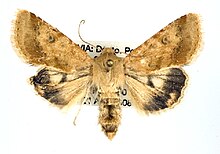댐퍼(식품)
Damper (food) 현대적인 댐퍼 | |
| 유형 | 소다빵 |
|---|---|
| 원산지 | 호주. |
| 지역 또는 주 | 원주민 문화 |
| 작성자 | 점원 |
| 주요 성분 | 밀가루, 소금, 물 |
댐퍼는 전통적으로 호주의 [1]초기 유럽 정착민들에 의해 만들어진 두꺼운 수제 소다 빵이다.이 빵은 호주 원주민에 의해 수천 년 동안 만들어졌으며 전통적으로 다양한 토종 씨앗, 견과류, 뿌리를 으깨서 반죽에 넣고 반죽을 불에 굽는 [2][3][4]방식으로 만들어졌다.다양한 원주민들의 이 기술이 캠프파이어의 [5][6][7]잿더미에서 비슷하게 요리된 식민지 시대의 댐퍼의 발전에 영향을 미쳤는지에 대한 조사가 진행 중이다.
댐퍼는 밀을 기반으로 한 반죽으로 만든 빵이다.밀가루, 소금, 물을 약간의 버터와 함께 캠프파이어의 석탄에 직접 또는 캠프 [8]오븐 안에서 가볍게 반죽하여 굽는다.이 댐퍼 "부시 스콘"은 개별 크기의 작은 양으로 요리될 때 종종 "조니 케이크"[9][10][11]라고 불립니다.이 이름이 북미 옥수수 가루 빵의 용어에 영향을 받았는지는 확실하지 않다.그러나 호주의 조니 케이크는 종종 팬에 튀기지만 밀을 기반으로 [12][9]합니다.
댐퍼는 오랜 기간 외진 지역을 여행한 목수들에 의해 사용되었고, 밀가루, 설탕, 차의 기본적인 배급량만 제공되었고,[1] 사용 가능한 모든 고기로 보충되었다.그것은 또한 무단거주자들의 [13]기본 제공이었다.댐퍼의 기본 재료는 밀가루, 소금, [14]물이었다.베이킹 소다나 맥주는 발효에 사용될 수 있다.댐퍼는 보통 모닥불의 잿더미 속에서 조리되었다.재는 납작해지고, 댐퍼는 종종 막대기에 감겨 10분 동안 구워졌다.이어 재로 덮은 뒤 두드리면 [15]속이 빈 소리가 날 때까지 20~30분 정도 더 익혔다.또는 댐퍼를 기름칠한 캠프 [16]오븐에서 조리했습니다.댐퍼는 건조되거나 요리된 고기나 황금 시럽과 함께 먹었다.
댐퍼는 호주의 상징적인 [1]음식이다.그 나라 내에서 전형적인 호주인으로 여겨지며 초기 유럽인의 정착과 시골 생활의 동의어로 여겨지지만, 제빵은 매우 오래되고 널리 퍼진 관습이기 때문에 이러한 형태의 빵 굽기는 식민지나 식민지 이전 [17]호주에만 있는 것은 아니다.다른 문화권도 비슷한 버전의 난로 빵을 가지고 있고, 소다 빵의 버전은 뉴질랜드와 영국에서 알려진 것처럼 세계 [7]많은 지역에서 캠핑 상황에서 만들어진다.
「 」를 참조해 주세요.
레퍼런스
- ^ a b c "The History of Australian Damper Little Aussie Travellers". Little Aussie Travellers. 10 December 2014. Retrieved 29 December 2016.
- ^ Pascoe, Bruce (2018). Dark Emu : Aboriginal Australia and the birth of agriculture. Broome, Western Australia. ISBN 9781921248016.
- ^ Wroth, David (August 2020). "Damper Seed - Aboriginal Art Stories - Japingka Gallery". Japingka Aboriginal Art Gallery. Retrieved 8 September 2020.
Millstones for grinding seeds into flour have been discovered, which have been dated to 50,000 years old.
- ^ Florek, Stan (5 August 2014). "Food Culture: Aboriginal Bread". The Australian Museum. Retrieved 13 February 2021.
- ^ Behrendt, Larissa (22 September 2016). "Indigenous Australians know we're the oldest living culture – it's in our Dreamtime Larissa Behrendt". The Guardian. Retrieved 14 February 2021.
- ^ "Australian Aboriginal people were baking bread and farming grain 20,000 years before Egypt ARCHAEOLOGY WORLD". Archaeology World. Retrieved 14 February 2021.
- ^ a b Newling, Jacqui; Hill, Scott. "Our daily bread The Cook and the Curator Sydney Living Museums". blogs.sydneylivingmuseums.com.au. Historic Houses Trust of NSW. Retrieved 14 February 2021.
- ^ "Australian food history timeline - Damper first mentioned". australianfoodtimeline.com.au. Retrieved 29 December 2016.
- ^ a b The Macquarie Dictionary. St. Leonards, N.S.W.: Macquarie Library. 1981. p. 954. ISBN 0949757004.
- ^ Santich, Barbara. "Bold Palates, Australia's Gastronomic Heritage". www.southaustralianhistory.com.au. Retrieved 13 February 2021.
- ^ Eley, Talisa (23 August 2017). "Food for thought at NAIDOC Week 2017". The Source News. Griffith University School of Humanities, Languages and Social Science Journalism Media Centre. Retrieved 13 February 2021.
- ^ Morris, Edward Ellis (1898). Austral English: A Dictionary of Australasian Words, Phrases, and Usages, with Those Aboriginal-Australian and Maori Words which Have Become Incorporated in the Language and the Commoner Scientific Words that Have Had Their Origin in Australasia. Macmillan. p. 253.
- ^ "Reviews: Australia, from Port Macquarie to Moreton Bay, &c. By Clement Hodgkinson". Simmonds's Colonial Magazine and Foreign Miscellany. Vol. 4, no. 13. Simmonds & Ward. 2 January 1845. p. 101. Retrieved 21 November 2021.
[excerpt from book]: I have myself known many squatters who, ... were content to live on an unvarying course of salt beef, damper, and tea; ..
- ^ "Van Diemen's Land. Tasmania Lakes". The Colonial Magazine and Commercial Maritime Journal. Fisher Son, & Co. 3 (11): 363. 1 November 1840. Retrieved 21 November 2021.
- ^ "Damper Details". www.theoldfoodie.com. Retrieved 29 December 2016.
- ^ "Damper (Australian Soda Bread)". Tara's Multicultural Table. 13 July 2016. Retrieved 29 December 2016.
- ^ Hayward, Tim (2020). Loaf Story A Love-Letter to Bread, with Recipes. London: Quadrille Publishing, Limited. ISBN 9781787134782.


